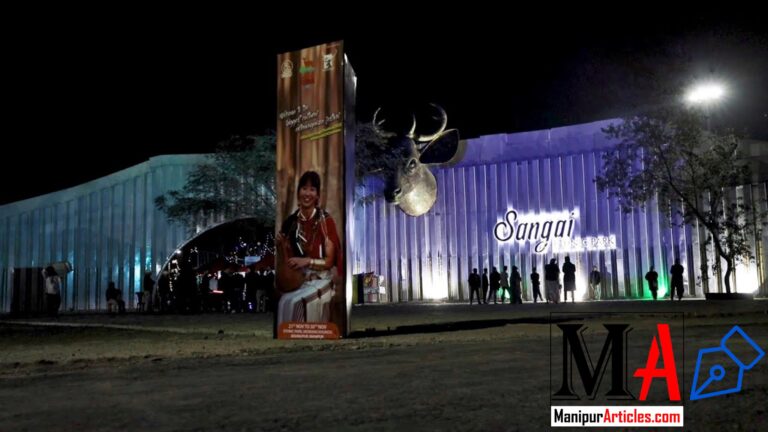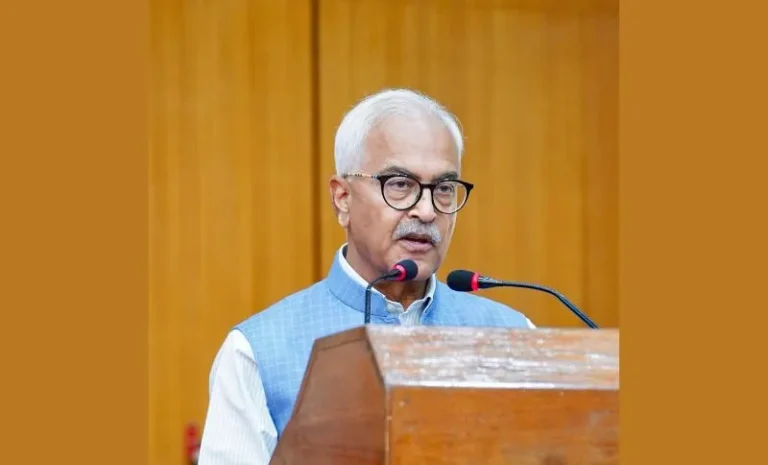Manipuri Film Ishanou to be Screened at LA Academy Museum: A Landmark Moment for Indian Cinema
Introduction: A New Era for Manipuri Cinema
Have you ever experienced a film that transports you straight into the heart of a culture so vivid and rich that it feels almost magical? That’s precisely what Ishanou does. This Manipuri gem is not just any film—it’s a doorway into the soul of Northeast India. Now, imagine this film being showcased at the renowned LA Academy Museum, a venue known for celebrating art and innovation. It’s like witnessing a beautiful fusion of tradition and modernity, a milestone that redefines the global narrative of Indian cinema.
The Journey of Ishanou: From the Heart of Manipur
Let’s take a step back and look at the fascinating journey of Ishanou. Born in the culturally diverse and historically vibrant region of Manipur, this film has been meticulously crafted to capture the essence of Manipuri life. The story is a heartfelt narrative that weaves together the threads of local traditions, emotions, and everyday struggles with an artistic finesse that is hard to ignore.
Think of it as a beautifully painted canvas where each stroke tells a story—a story of resilience, beauty, and the eternal dance of tradition and modernity. With its striking visuals, soulful music, and compelling narrative, Ishanou has already carved a niche for itself among audiences who are keen to explore authentic regional cinema.
Landmark Screening at the LA Academy Museum
So, why is the screening of Ishanou at the LA Academy Museum such a big deal? Imagine stepping into a world-renowned museum that not only preserves history but also celebrates groundbreaking art and cinema. Hosting Ishanou as part of a landmark Indian cinema series signals a tremendous acknowledgment of the film’s artistic merit and the rich cultural narrative it represents.
The LA Academy Museum is a beacon of art, culture, and innovation, drawing in global audiences who appreciate masterpieces that push creative boundaries. By including Ishanou in its lineup, the museum is not only showcasing a film—it is offering a window into a vibrant cultural universe that has been waiting to be discovered by international cinephiles.
Significance of the Event for Indian Cinema
You might be wondering, “What does this event mean for the broader landscape of Indian cinema?” The answer lies in the symbolism and impact of the event. For years, mainstream Indian cinema has dominated the global scene, often overshadowing regional narratives. This screening is a groundbreaking moment that places Manipuri cinema—and by extension, the diverse voices of Northeast India—on the international map.
It’s like finally giving a stage to that hidden gem in a treasure chest, allowing the world to experience a different flavor of Indian storytelling. This event underscores a shift towards embracing regional diversity, highlighting that true art isn’t confined by language or geography. The narrative of Ishanou speaks to universal themes of love, loss, hope, and transformation—elements that resonate with audiences worldwide.
Cultural Impact and Representation
Cultural representation in cinema is crucial, and Ishanou stands as a shining example of this. The film brings forth the unique cultural identity of Manipur, its traditions, and its way of life. For many viewers, it’s an invitation to explore a part of India that is rarely in the limelight, a region where every ritual, dance, and festival tells a story of ancient wisdom and modern perseverance.
Imagine a vibrant tapestry where every thread represents a different aspect of culture—each color, each pattern, tells its own tale. That’s what Ishanou offers: a mosaic of emotions, traditions, and narratives that collectively paint a picture of a community rich in heritage and spirit. The film’s screening at an international venue like the LA Academy Museum is a testament to the growing recognition of these narratives, offering a platform for voices that have long been underrepresented.
The Role of Indian Cinema in Global Cultural Exchange
Indian cinema has long been a powerful tool for cultural exchange, bridging diverse worlds with stories that transcend borders. With Ishanou being screened internationally, there’s a unique opportunity to showcase the nuances of Manipuri culture to a global audience. It’s like opening a cultural passport that allows viewers to travel, not through geography, but through the deep, resonant stories of a community.
This exchange is not just about entertainment—it’s about fostering mutual understanding and appreciation. As international audiences immerse themselves in the world of Ishanou, they get a glimpse of the rich cultural landscape of Northeast India. Such experiences are invaluable in today’s globalized world, where every film becomes a conversation starter, a bridge connecting diverse cultures and ideologies.
Innovative Storytelling and Cinematic Techniques in Ishanou
What makes Ishanou so special? At its core, the film is a masterclass in innovative storytelling. The filmmakers have brilliantly blended traditional narrative techniques with modern cinematic tools to create a visual and emotional feast. Every frame of the film is like a carefully composed painting, rich in detail and imbued with the spirit of its cultural roots.
The use of natural landscapes, traditional music, and authentic dialects not only adds depth to the narrative but also creates an immersive experience for the viewer. It’s akin to taking a scenic road trip through the hidden lanes of Manipur—each turn revealing breathtaking vistas, unexpected stories, and moments of profound beauty. The film’s innovative approach has set a new benchmark for regional cinema, challenging conventional storytelling methods and inviting audiences to see beyond the ordinary.
Behind the Scenes: Production, Challenges, and Triumphs
Creating a film like Ishanou is no small feat. It’s a journey marked by passion, perseverance, and a deep commitment to authenticity. The filmmakers had to navigate numerous challenges, from limited budgets and resources to the task of preserving the authenticity of a culturally rich narrative. Yet, despite these hurdles, they managed to create a film that is both artistically brilliant and emotionally stirring.
Imagine the process as akin to sculpting a delicate statue out of clay—each moment of hardship, each creative struggle, contributes to the final masterpiece. The team behind Ishanou worked tirelessly, driven by a shared vision to tell a story that truly represents the heart and soul of Manipur. Their success is not just a win for regional cinema, but a reminder that with passion and determination, artistic excellence can bloom even in the most challenging environments.
What Does This Screening Mean for Emerging Filmmakers?
For emerging filmmakers, the international screening of Ishanou is a beacon of hope and inspiration. It demonstrates that unique, culturally rich stories have the power to resonate on a global scale, even when they come from regions that are often overlooked by mainstream media. This event sends a powerful message: authenticity and originality are celebrated, and every voice deserves to be heard.
Consider this as a rallying cry for budding filmmakers—an invitation to tell their own stories, to embrace their cultural roots, and to innovate without fear. The success of Ishanou proves that there is an eager audience out there waiting for fresh perspectives, for narratives that challenge the status quo and celebrate the beauty of diversity. For those starting out, it’s a reminder that every creative struggle is worth it when the final product speaks to the heart of people across the world.
Future of Manipuri Cinema and Beyond
As we stand at this crossroads of tradition and modernity, the future of Manipuri cinema looks incredibly promising. The international recognition that comes with events like the screening at the LA Academy Museum will undoubtedly inspire more filmmakers from the region to take creative risks and push the boundaries of storytelling.
Looking ahead, one can only imagine the possibilities—a surge in high-quality productions that blend traditional narratives with modern techniques, more platforms for regional films to be showcased internationally, and a burgeoning community of filmmakers who are eager to share their stories with the world. The ripple effects of this event could very well spark a renaissance in Northeast Indian cinema, opening doors for collaborations, funding, and global partnerships that were once unimaginable.
Celebrating Diversity Through Cinema
At its heart, cinema is a celebration of diversity. Ishanou is not just a film—it’s a cultural ambassador that brings the stories of Manipur to life on an international stage. It’s a celebration of the unique voices, traditions, and artistic expressions that make Northeast India so special.
Think of cinema as a grand mosaic where every film is a tile contributing to the larger picture of human experience. Each story, each visual narrative, adds color and depth to this mosaic, reminding us that beauty lies in our differences. The screening of Ishanou at the LA Academy Museum is a powerful reminder of this truth, offering audiences an opportunity to experience a slice of life from a region that has so much to offer.
The Broader Impact on Indian Cinema
This event isn’t just about one film—it’s about setting a precedent. When a film like Ishanou gets the recognition it deserves, it paves the way for more regional films to enter the global arena. It challenges the traditional hierarchies within the film industry and encourages a more inclusive approach to storytelling.
By celebrating the unique narratives of different regions, the broader Indian cinema landscape becomes richer and more diverse. It’s like adding new instruments to an orchestra—the resulting symphony is more vibrant, more nuanced, and far more reflective of the country’s true cultural heritage. This is the power of cinema: it can break barriers, foster understanding, and unite people through shared experiences.
Innovative Collaborations and Cultural Exchange
The screening at the LA Academy Museum also opens up exciting avenues for innovative collaborations between filmmakers, cultural institutions, and international art curators. Such partnerships can lead to joint projects, film festivals, and workshops that further enrich the cinematic experience and promote cross-cultural dialogue. Imagine a scenario where filmmakers from different parts of the world come together, each bringing their unique perspectives to the table—this kind of exchange can lead to groundbreaking projects that redefine the global narrative of cinema.
These collaborations are essential in today’s interconnected world. They not only broaden the horizon for regional filmmakers but also educate global audiences about the rich, diverse cultural heritage of India. The event is a reminder that art and culture are universal languages, capable of transcending geographical boundaries and uniting us in our shared human experience.
Bridging the Gap Between Traditional and Contemporary Narratives
One of the most striking aspects of Ishanou is its ability to bridge the gap between traditional storytelling and contemporary cinematic techniques. The film’s narrative is rooted in the rich tapestry of Manipuri traditions, yet it is presented with a modern sensibility that appeals to today’s audiences. This balance is a testament to the filmmakers’ ability to honor their cultural heritage while embracing innovation.
It’s like blending an age-old recipe with a modern twist—the result is something familiar yet refreshingly new. By doing so, Ishanou not only captivates viewers with its authenticity but also demonstrates that traditional narratives can evolve and remain relevant in an ever-changing world. This approach sets an inspiring example for future filmmakers who wish to honor their roots while experimenting with new forms of storytelling.
Economic and Social Impact
Beyond artistic recognition, events like these have far-reaching economic and social implications. Increased visibility of regional films on international platforms can lead to better funding opportunities, growth in local film industries, and even boost tourism as audiences become curious about the cultures behind these narratives. For communities in Manipur and other parts of Northeast India, such recognition fosters a sense of pride and can stimulate local economies by encouraging cultural tourism and creative industries.
This cultural renaissance is not just an artistic movement—it’s an economic catalyst. As more films like Ishanou gain international acclaim, they inspire investments in local talent and infrastructure, creating a sustainable ecosystem for regional cinema to thrive.
Empowering the Next Generation of Storytellers
Perhaps one of the most inspiring aspects of this landmark screening is its potential to empower the next generation of filmmakers. Young creatives from Northeast India now have a powerful example to emulate—a reminder that their stories, no matter how rooted in tradition, have the power to resonate globally. This event is a call to action, urging young filmmakers to pursue their visions with courage and authenticity.
Imagine a young artist in a small town, inspired by Ishanou, picking up a camera for the first time. That spark of inspiration can ignite a movement, one where diverse narratives flourish and contribute to a more inclusive global film culture. The success of Ishanou at the LA Academy Museum is a testament to the fact that every voice matters and that true creativity knows no bounds.
Conclusion: Celebrating Diversity and the Future of Indian Cinema
In wrapping up our exploration of this monumental event, it’s clear that the screening of Ishanou at the LA Academy Museum is much more than a simple film show—it’s a celebration of cultural diversity, artistic innovation, and the enduring power of storytelling. It highlights the richness of Manipuri cinema and reaffirms that every region in India has a unique story to tell.
As audiences around the world tune in to this film, they are not just watching a movie—they are embarking on a cultural journey that deepens their understanding of the vibrant tapestry that is Indian cinema. This event sets the stage for future collaborations, more international screenings, and an ever-growing appreciation for the diverse voices within India.
So, if you’re a lover of cinema that challenges the ordinary, a seeker of cultural tales that speak to the soul, or simply someone curious about the myriad expressions of human experience, Ishanou is a film you won’t want to miss. Let’s celebrate this landmark moment and look forward to a future where every story, no matter how small or regionally rooted, finds its rightful place on the global stage.
FAQs
- What is the film Ishanou about?
Ishanou is a Manipuri film that weaves together the rich cultural traditions of Manipur with a contemporary narrative, capturing the essence of the region’s heritage through innovative storytelling and striking visuals. - Why is the screening of Ishanou at the LA Academy Museum significant?
This screening marks a major milestone as it highlights the global recognition of regional Indian cinema. It offers an international platform for the unique narratives of Northeast India and promotes cultural diversity in film. - How does Ishanou bridge traditional and modern cinematic techniques?
The film expertly blends age-old storytelling methods rooted in Manipuri traditions with modern visual and narrative techniques, creating an immersive experience that resonates with both traditional and contemporary audiences. - What impact can international screenings have on regional cinema?
International screenings can significantly boost the visibility of regional films, attracting new audiences, fostering cultural exchange, encouraging investments in local talent, and ultimately leading to a renaissance in regional filmmaking. - What message does Ishanou send to emerging filmmakers?
Ishanou inspires emerging filmmakers by demonstrating that authentic, culturally rich stories have universal appeal. It encourages new talent to embrace their heritage, innovate boldly, and share their unique voices with the world.




